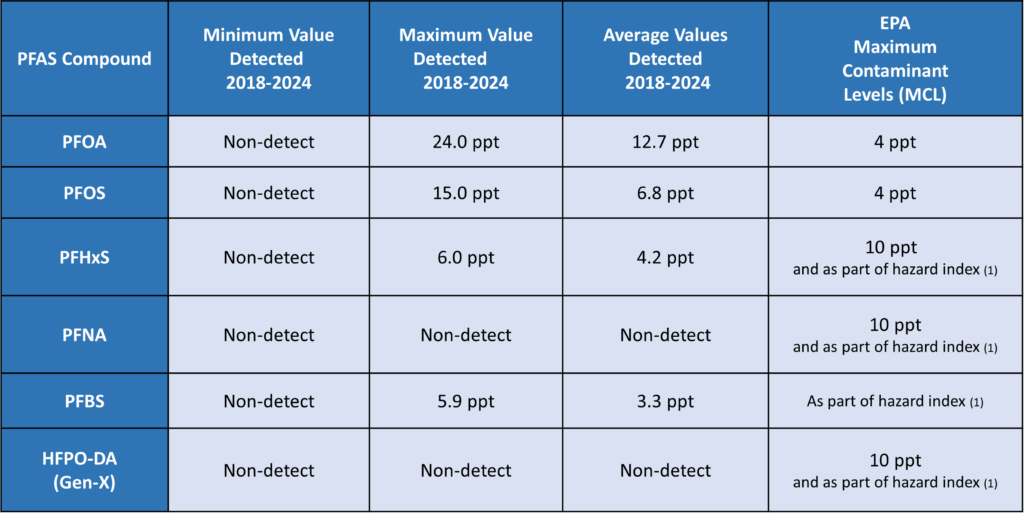PFAS & Your Water: Drinking Water Monitoring & Treatment
How much PFAS is in our community’s drinking water?
Six PFAS compounds are the focus of the EPA’s regulations on PFAS in drinking water. Our most recent monitoring data, completed during the first quarter of 2024, detected PFOA at 3.3 ppt in our finished drinking water. PFOS was not detected in our finished drinking water but has been detected in the past. PFHxS and PFBS were not detected during first quarter sampling but have been detected in the past. HFPO-DA (Gen-X) and PFNA have never been detected in our treated drinking water. Maximum, minimum, and average values detected of these six PFAS compounds in drinking water since 2018 are:

One part per trillion (ppt) can be visualized as one grain of sand in an Olympic-size swimming pool.
Over the last five years, we have detected an additional five PFAS compounds in our treated drinking water. Details on the results of each PFAS compound detected in our treated and source water are summarized in the dashboard below.
What is OWASA doing about PFAS?
We are working toward strategies to further reduce levels of PFAS in our drinking water. In the near term, we are improving a part of our current treatment process; in the long term, we are:
Monitoring: We are continuing to monitor our water supply, drinking water, wastewater, and biosolids. Monitoring provides data for research, helps us understand our water and our current treatment effectiveness on PFAS, and informs our solutions.
Engineering a Solution: Using an existing part of our treatment process (powdered activated carbon), we hope to see reductions in PFAS beyond those we see with our current treatment process. However, this will not be enough to meet our goals. In spring 2024, we will begin pilot testing a combination of two technologies that small-scale testing showed would work well on OWASA’s source water.
Design and Construction: Concurrent to the pilot testing, we will begin 12 to 14 months of design for a new treatment process and facilities, followed by 18 to 24 months of construction. We anticipate enhanced treatment for PFAS removal being online in 2027/2028.
Holistic Response: While the EPA’s proposed standard is focused on drinking water and our near-term focus is on drinking water treatment, our ultimate response will include addressing PFAS throughout our system.
Tributaries of Cane Creek Reservoir
While working to investigate PFAS levels in Cane Creek Reservoir source water, OWASA conducted monitoring of tributaries that feed the reservoir. In some areas, this monitoring showed much higher levels of PFAS than in the water taken in from Cane Creek Reservoir at our intakes for several compounds. The levels of PFAS found in the tributaries is not what is in the water entering the treatment plant nor in your drinking water. Our monitoring suggests that the presence of PFAS in Cane Creek Reservoir could be from previous biosolids land application practices in the watershed.
The map below shows where our samples were taken and the levels detected for individual compounds, relative to previously used biosolids land application fields.



